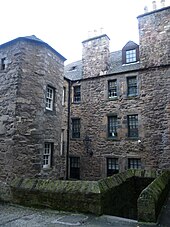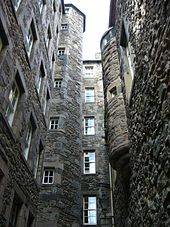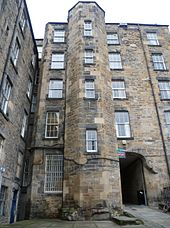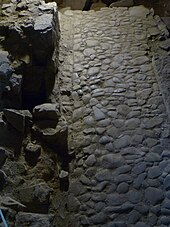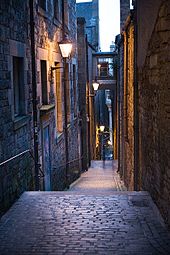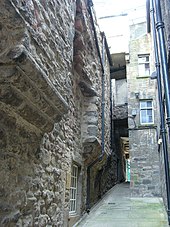
The Royal Mile is a succession of streets forming the main thoroughfare of the Old Town of the city of Edinburgh in Scotland. The term was first used descriptively in W. M. Gilbert's Edinburgh in the Nineteenth Century (1901), describing the city "with its Castle and Palace and the royal mile between", and was further popularised as the title of a guidebook by R. T. Skinner published in 1920, "The Royal Mile (Edinburgh) Castle to Holyrood(house)".

An alley or alleyway is a narrow lane, path, or passageway, often reserved for pedestrians, which usually runs between, behind, or within buildings in the older parts of towns and cities. It is also a rear access or service road, or a path, walk, or avenue in a park or garden.

Thomas Hamilton was a Scottish architect, based in Edinburgh where he designed many of that city's prominent buildings. Born in Glasgow, his works include: the Burns Monument in Alloway; the Royal High School on the south side of Calton Hill ; the Royal College of Physicians of Edinburgh; the George IV Bridge, which spans the Cowgate; the Dean Orphan Hospital, now the Dean Gallery; the New North Road Free Church, now the Bedlam Theatre; Cumstoun, a private house in Dumfries and Galloway; and the Scottish Political Martyrs' Monument in Old Calton Cemetery, Edinburgh.

Calton Hill is a hill in central Edinburgh, Scotland, situated beyond the east end of Princes Street and included in the city's UNESCO World Heritage Site. Views of, and from, the hill are often used in photographs and paintings of the city.
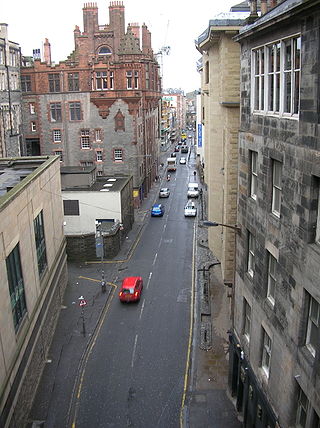
The Cowgate is a street in Edinburgh, Scotland, located about 550 yards (500 m) southeast of Edinburgh Castle, within the city's World Heritage Site. The street is part of the lower level of Edinburgh's Old Town, which lies below the elevated streets of South Bridge and George IV Bridge. It meets the Grassmarket at its west end and Holyrood Road to the east.

This article is a timeline of the history of Edinburgh, Scotland, up to the present day. It traces its rise from an early hill fort and later royal residence to the bustling city and capital of Scotland that it is today.
Edinburgh, the capital of Scotland, is traditionally said to have been "built on Seven Hills", in an allusion to the seven hills of Rome. While there is considerable room for debate as to which hills are included and excluded from the seven, seven possibilities are listed in an old rhyme:

The Old Town is the name popularly given to the oldest part of Scotland's capital city of Edinburgh. The area has preserved much of its medieval street plan and many Reformation-era buildings. Together with the 18th/19th-century New Town, and West End, it forms part of a protected UNESCO World Heritage Site.

George IV Bridge is an elevated street in Edinburgh, Scotland, and is home to a number of the city's important public buildings.

Younger's Brewery was a brewery in Edinburgh which grew from humble beginnings in 1749 to become one of the city’s main commercial enterprises, supplying domestic and foreign markets. It should not be confused with another, less renowned Edinburgh brewery, that of Robert Younger, who also brewed in Holyrood at the St. Ann's Brewery or that of George Younger, who brewed in Alloa.

There have been several town walls around Edinburgh, Scotland, since the 12th century. Some form of wall probably existed from the foundation of the royal burgh in around 1125, though the first building is recorded in the mid-15th century, when the King's Wall was constructed. In the 16th century the more extensive Flodden Wall was erected, following the Scots' defeat at the Battle of Flodden in 1513. This was extended by the Telfer Wall in the early 17th century. The walls had a number of gates, known as ports, the most important being the Netherbow Port, which stood halfway down the Royal Mile. This gave access from the Canongate which was, at that time, a separate burgh.

The Canongate Kirkyard stands around Canongate Kirk on the Royal Mile in Edinburgh, Scotland. The churchyard was used for burials from the late 1680s until the mid-20th century.
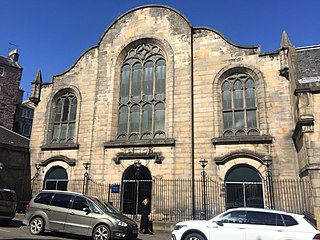
Lady Yester's Kirk was a parish church of the Church of Scotland and one of the burgh churches of Edinburgh. Founded in 1647, it served the south-eastern part of Edinburgh's Old Town until its union with Greyfriars Kirk in 1938.
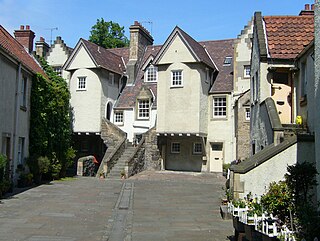
White Horse Close, or "Whitehorse Close", is an enclosed courtyard off the Canongate at the foot of the Royal Mile at the eastern end of the Old Town of Edinburgh, Scotland. It was formerly known as "Ord's Close", after Laurence Ord, the putative builder of the 17th-century inn at its northern end. Because of several conversions to its buildings in the past, the close has been described as "so blatantly fake that it can be acquitted of any intention to deceive". Professor Charles McKean has characterised it as "heritage rather than history".
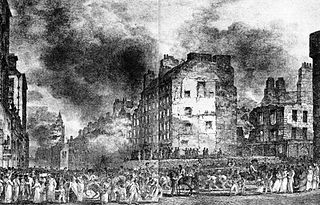
The Great Fire of Edinburgh was one of the most destructive fires in the history of Edinburgh. It started on Monday, 15 November 1824, and lasted for five days, with two major phases.

Robert Wilson was architect for the Edinburgh Board of Education and responsible for a high percentage of the city's schools. He is also noteworthy for involvement in several institutions aimed at improving the life of the poor and destitute in the city.
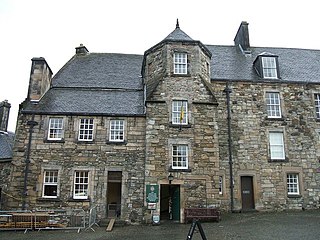
Walter Merlioun, was a Scottish master mason based in Edinburgh.

The Collegiate Church of St Mary in the Fields was a pre-Reformation collegiate church in Edinburgh, Scotland. Likely founded in the 13th century and secularised at the Reformation, the church's site is now covered by Old College.


